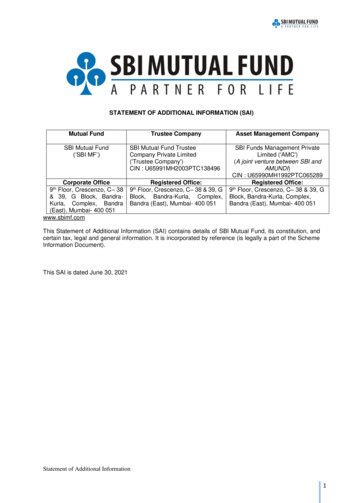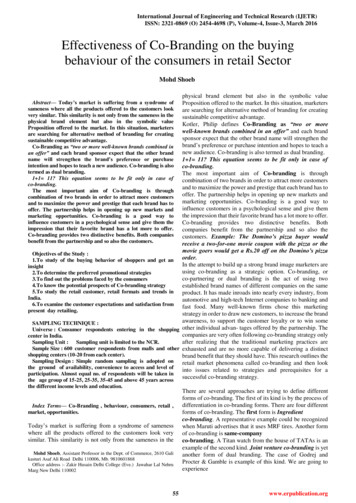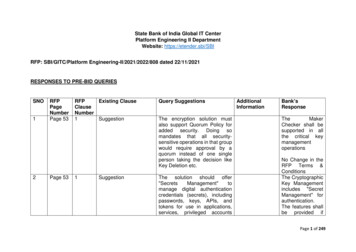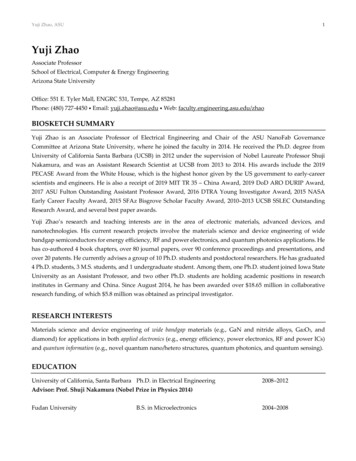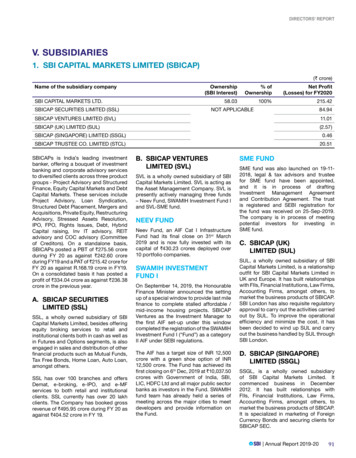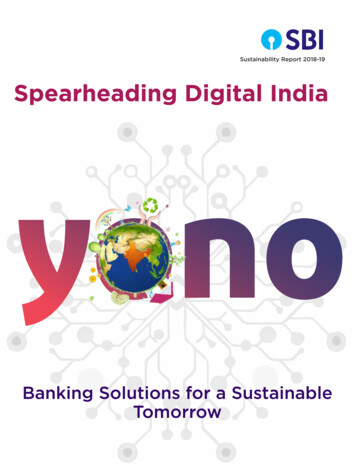
Transcription
yono
In This Report01Message fromthe Chairman03LeadershipStatement05About theReport07State Bank ofIndia- at a Glance11GoverningResponsibly17Stakeholder Engagement& Materiality Assessment23FinancialCapital Management
35HumanCapital Management43Social and RelationshipCapital Management63NaturalCapital Management77GRIContent Index82BRR Mapping86SDG Mapping87Glossary
Message from theChairman39.75CroreThe BC channel recorded39.75 crore transactionsin FY 2018-19, whichtranslated toapproximately 1.5 milliontransactions per day.Dear Reader,Serving the country's citizens has been a corecommitment of State Bank of India (SBI) which is deeprooted in its ethos. For over 200 years, we have alwaysstriven to strengthen the country's financial system andare strongly interlinked with India's growth story. Ourcontribution to the economic and social developmentcanvas of the country- propelled the by Bank's vastoutreach- remains unparalleled. Customer centricity hasdriven us to evolve over the years and we havecontinuously taken steps to stay relevant. The digitaldisruption that we're currently witness to, has broughtabout a new financial order- a paradigm shift in the wayproducts and services are being rendered to customers.The use of new technology has become a standardcross-cutting theme across most operational businesspractices, and this is no different for SBI. We haveembarked on the journey of digitally transforming ourbanking products and services and are well on our wayto support the ‘Digital India’ vision. In the quest ofimproving our sustainable performance and becoming acarbon neutral bank by 2030, SBI has begun integratingits digital strategy with its overall sustainability strategy.In light of this, SBI is happy to present its fourthSustainability Report for FY 2018-19- “SpearheadingDigital India-Banking Solutions for a SustainableTomorrow”. While one of the guiding principles for theBank has always been to engender inclusive growth, weare now using our sustainability strategy to re-look intoour specialized products and services for the urban aswell as rural customers and the best way to integratethem into the formal economy. Using digital platformshas served as one of the most effective modes offulfilling this objective. YONO- the Bank's flagship digitalapp for retail customers launched in November 2017, hascrossed several milestones. As an integrated omnichannel digital platform, YONO today, offers bothlifestyle and banking experiences with more than 30products live on a financial superstore and nearing 90merchant partners live on the B2C Market Placeplatform across 21 categories. Our financial inclusion (FI)and financial literacy programs have also been designedto incorporate digital aspects into the activities. Thespread of digital banking channels and expansion of theBusiness Correspondent (BCs) network have given theBank the impetus to further grow its FI activities. SBIhas re-looked at several strategies and leveragedtechnology to expand financial services provided to newsegments of customers and bring them under the ambitof a formal banking system.102-14, 102-15, 103-21
The BC channel recorded 39.75 crore transactions in FY19, which translated to approximately 1.5 milliontransactions per day. Through its 338 Financial LiteracyCenters (FLC's), SBI has conducted over 29,000 campswith the objective of enhancing financial literacy.Similarly, to help rural youth gain requisite employabilityand livelihood skills, the RSETIs supported by the Banktrained nearly 97,000 rural youth during the reportingperiod. Additionally, our pledge for communitydevelopment has stood solemn over the years focusingon key thematic areas viz. Healthcare, Education,Sanitation, Culture, Sports, Environment Protection etc.have been adopted to enhance talent and productivityat the workplace whilst enabling HR managers to focuson driving business profitability. SBI is the largestemployer in the Indian banking sector – employing over2.5 lakh number of people. Despite the challengesinvolved with a large workforce, several new technologydriven initiatives have been rolled out to effectivelymanage and empower our human capital. A real timehelp platform, 'e-Gyanshala', has been launched on apilot basis, serving as a one-stop knowledge repositoryfor all employees wishing to access guidance documentsrelated to operational instructions.The reporting period also witnessed the public issue ofthe Bank's maiden Green Bond-a continuedcommitment towards green financing and clean energy.The new era of technological innovation is changing theway organisations view traditional business functionssuch as human resource management. Several toolsThe impact of digital innovation on the environment, has been an importantarea of achievement for us. We've made significant investments in ArtificialIntelligence, the Internet of Things (IoT), Robotics, Branch Serverconsolidation etc. which has led to enhanced energy efficiency and reducedcarbon footprint.During the reporting period, the Bank launched Phase –Iof “Nayi Disha”- a corporate communication programwith the objective of driving home the significance ofbeing agile, inculcating the Bank's values throughemployee engagement and enhancing customercentricity. The programme has been designed as anongoing intervention in phases covering all employees.Technology based solutions have also become thefoundation of the Bank's lending activities. In FY 2017-18,State Bank of India won the Asian Banker Awards for thebest lending initiative—proof of the extent to which theculture of innovation and digitisation has been so widelyembedded within the Bank. Digitisation of various creditprocesses and products is being done through extantinstructions, adherence to credit policies and guidelines- with a view to manage risk, ensure regulatorycompliance and develop reliable information systems.Additionally we are continuously exploring the optionsof Blockchain, analytics-backed predictive models andother innovative technologies to strengthen our lendinginitiatives.The scope of complete digital transformation for a Bankas large as SBI is both extraordinary, and challenging.While we have begun taking strong steps in the rightdirection, we still have a long way to go in terms ofbecoming a Bank whose products and services aredriven primarily via digital platforms.Our progress towards sustainable growth anddevelopment is reviewed periodically and the necessaryactions are outlined to improve our performance on anannual basis.While I have taken the liberty to highlight some of thekey initiatives taken during the reporting period, wehave provided a detailed discussion on severalsustainability parameters in the pages ahead. We lookforward to receiving any feedback or suggested areas ofimprovement from you on the same.Thank you.Rajnish KumarChairman, State Bank of India.102-14, 102-15, 103-22
Message from the leadershipShri Praveen Kumar GuptaShri Dinesh Kumar KharaManaging Director, Retail & Digital BankingManaging Director, Global Banking and Subsidiaries“Digital transformation through smart technologyapplications and refined customer orientation havebeen two areas of significant intervention for us. Ourdedicated focus on supplementing conventionalbanking practices with new, emerging technologyhas yielded positive results- enabling the Bank tostreamline several of its internal controls, processesand banking services for customers. In this new ageof digital revolution, it's easy to get caught up in thestorm of embedding technological applications.However, SBI has developed outcomes for itsinvestment in this space with a clear sight on its longterm business continuity. Additionally, digitalinterfaces have strongly facilitated theaccomplishment of financial inclusion and literacyactivities - enhancing the impact for eachbeneficiary with an underlying vision of a DigitalIndia in the backdrop.”“The values that were defined for the Bank since itsinception haven't changed over time. In fact, we haveadded on to those values to keep up with the rapidlyevolving eco-system and to continue providingbanking services that promote and supportsustainable growth of all our stakeholders. Thestakeholder groups that we consider vital for longterm business continuity have also expanded throughthe years. We are dedicated towards implementingsustainability programs across our entire value chainincluding safeguarding our natural environment. Asthe global banking landscape changes, the truepurpose of financial institutions is to now supportactions that will help create long term, positiveimpacts through its banking and lending activities.SBI, in its journey of sustainable growth, iscontinuously looking for different ways in which itcan increase the scope of its impact.”102-15,103-23
Shri Arijit BasuSmt Anshula KantManaging Director, Commercial Clients Group & ITManaging Director, Stressed Assets, Risk and Compliance“Meaningful collaborations with new age fintechcompanies have changed the way banking and otherfinancial institutions conduct business. Using dataanalytics and algorithms that form the backbone oflending decisions, apps that support virtualverification and account opening activities and digitalplatforms that provide banking services anywhere,anytime is helping SBI re-model the manner in whichfinancial services are disseminated. We are movingtowards a customer friendly, ‘Less paper’environment.“The global and Indian regulatory landscape is in astate of constant flux to maximise support foreconomic growth as well as maintain high standardsfor compliance and risk. For the banking sector, theattention is currently focused towards issues such aswork culture, corporate governance and the demandsof adapting to new technology, volatile marketconditions, data security and cyber risk, amongothers. Assessing risk in an integrated manner andensuring compliance to all relevant statutory rulesand regulations has helped SBI build its brand andreputation. Our renewed focus on implementingethical practices is helping the Bank gain acompetitive advantage by ensuring that each andevery business function adheres to stringent ethicalstandards, both in letter and in spirit.”We have also identified an additional area ofintervention during the reporting period– theintegration of ESG parameters into our lendingactivities. While SBI already has a screening processin place to ensure that the borrower is fully compliantwill all environmental and social statutory regulations,we want to go beyond compliance and move towardsvalue creation. Therefore, we have started theprocess of assessing different ways in which key ESGparameters can be used to screen and evaluate newinvestment opportunities.”102-15,103-24
About the ReportAfter the financial crisis of2008, the global financialstalwarts were forced to replaceshort term investment gainswith long term thinkingsupporting sustainable businesspractices, sustainableinvestment opportunities andan in-depth considerationtowards developing a robust,internal sustainability strategy.Since then, organisationaldisclosures on extra-financialparameters such asenvironment, social andgovernance (ESG) issues havebeen mandated throughregulatory reform in severalcountries. ESG issues that fallunder the broader umbrella of'sustainable practices' has onlygarnered more importance overthe last few years and is nowconsidered to be an integralpart of sustainable finance.Further, increased investorinquiries into the sustainabilityperformance and lendingpractices of financialinstitutions has helped drivesustainability reporting withinthe financial sector. A biennialsurvey conducted in FY 2016-17,showed that approximately 73%of the top financial companiesreport on its corporateresponsibility practices globally.73%In FY 2017, a survey showedthat approximately 73% of thetop financial companies reporton its corporate responsibilitypractices globally.*In the Indian context, a majority of the leading private banks havebeen consistently disclosing information on sustainability issuesacross different reporting platforms. Within the public sector, SBItook up the challenge of becoming a leader in the sustainabilityspace four years ago and has since, strengthened its economic,environmental and social strategy, and focus on its performance onan annual basis. SBI is currently the only public sector bank topublish a sustainability report in India and took a conscious decisionto release its previous FY 2017-18 sustainability report on 5th June,World Environment day.Spearheading Digital India-Banking Solutions for a SustainableTomorrow is SBI's fourth consecutive report for FY 2018-19presenting data for the period of 1st April 2018 to 31st March, 2019.This report has been prepared in accordance with the GRIStandards: Core Option. Additionally, it fulfills the requirements ofthe 10 principles outlined by the Standards. The content of thereport discusses information relevant to the Bank’s material issues,identified through an inclusive stakeholder engagement process.The chapter titled 'Stakeholder Engagement and MaterialityAssessment' highlights the process followed and the results of theanalysis in a more comprehensive manner.The principles put forward by the Integrated Reporting ( IR )Framework and National Voluntary Guidelines (NVG) have also beenreferred to as additional guidelines for the report development. AsIndia steadily progresses towards achieving its targetedSustainability Development Goals (SDGs) by 2030, SBI like otherlarge corporations, have aligned key initiatives to specific SDGtargets.The economic, environment and social disclosures cover SBI's Indianoperations only, which includes its Corporate Office headquarteredin Mumbai, its subsidiaries and its 17 circles across the country. The17th circle was inaugurated in April 2019. There hasn't been anychanges in the organisation's structure or supply chain from theprevious reporting period and no restatements of information are tobe made either.* Source- The KPMG Survey of Corporate Responsibility Reporting 2017102-46, 102-49, 102-50, 102-52, 102-545
Advisory Statement: We have included “forward-looking statements” in this report describing the Bank's objectives,projections, and expectations for long term value creation with respect to its business context. Critical factors that could make adifference to the Bank's operations include, among others, strategic internal decisions, external domestic and internationalmarket conditions in which SBI operates, modification to government regulations, laws and other statutes and incidental factors.Precautionary Principle: For a bank as significant as SBI in terms of size and influence, it is important to have the rightsystems and processes in place to ensure the appropriate identification and management of all critical risks. Therefore, theBank's precautionary approach has been articulated through the information disclosed on its internal controls and practices inplace for mitigating risk and managing its economic, environmental and social performance. The extensive volume of bankingservices and lending practices provided makes it imperative for the Bank to govern extra-financial issues that impact theorganisation and vice versa. The organisation has a robust set of policies and frameworks in place to ensure the same. It has alsodeveloped a standalone Sustainability and Business Responsibility Policy that is used as a guide to direct it’s overallsustainability performance.Message from the Chief Sustainability Officer“It's important to consider our stakeholders' perception ofSBI's brand value. The global risks identified for 2019 bythe World Economic Forum (WEF) makes it imperative forus to assess the diverse aspects that the Bank mustaddress instead of limiting the issues to just financialreturns, market share and shareholder profit.Implementing environmentally conscious best practices,positioning ourselves as a forward-thinking corporate,initiating responsible behavior, building relationshipsbased on trust and aligning the over-arching agenda forsustainable development with our business strategy arekey actions that will help SBI stay ahead of the curve.In an effort to grow holistically, the Bank's sustainabilityand CSR initiatives have been mapped to those SDGs thatare most relevant to us. Fighting poverty, supporting goodhealth and well-being, providing access to qualityeducation, promoting gender equality, investing in cleanenergy and climate action are some of the vital areas thatSBI is keenly looking into.”Shri Prashant KumarDeputy Managing Director (HR) & Corporate Development Officer102-116
State Bank Of Indiaat a GlancePersonalBankingIntroductionThe State Bank of India (SBI) is a Government-owned, Indian multinational, public sector banking andfinancial services company. It is the largest commercial bank in India in terms of assets, deposits, branches,customers and employees. As on 31st March 2019, the Bank operated 22,010 branches, managed 58,415ATMs and employed more than 2.5 lakh people. It ended the financial year with a total customer base ofmore than 43 crore. With over 141 lakh registered users, the mobile banking channel had processedtransactions amounting to INR 2,74,029 crore. In an attempt to enhance its interaction with its customers,especially those falling under the younger demographic, SBI has made its presence felt on various socialmedia platforms. For example, it has the highest number of followers on Facebook and Youtube amongstall the banks in the world. It also has a strong influence on LinkedIn and Pinterest. Headquartered inMumbai, SBI offers a wide spectrum of products and services to different segments of customers. Thisincludes personal banking services, SME &corporate banking and wealth management services. Incollaboration with its non-banking subsidiaries and joint ventures, the Bank also offers several otherproducts and services in the sectors of life insurance, general insurance, merchant banking, mutual funds,credit cards, factoring services, security trading and primary dealership. The details of SBI's operatingcompanies, subsidiaries and joint ventures can be found using the link nkingInternationalBankingAgricultural/ RuralBankingNRIBankingOtherServicesFigure 1: Products and Services offered by gPrimaryDealershipFigure 2: Products and Services offered by SBI in collaboration with its non-banking subsidiaries and joint ventures102-1, 102-2, 102-3, 102-4, 102-5, 102-6, 102-7, 102-457
The International Indian BankSBI was the pioneering Indian bank to transcend national borders. The Bank of Madras was inaugurated in Colombo, Sri Lanka inJuly, 1864, followed by the Imperial Bank of India in London in 1921. As on 31st March 2019, SBI's global footprint encapsulated208 overseas offices in 34 countries. The ownership details of SBI can be found in the Annual Report 2018-19.SBI's Operations for International Business1918141Ÿ20Branches / OfficesRep OfficeBrazil (1)ŸŸŸŸBelgium (1)Germany (1)France (1)UK (2)SubsidiariesŸŸRussia (1)UK (12)Rep OfficeŸTurkey (1)ŸŸUSA (3)Bahama (1)SubsidiariesŸŸCalifornia (7)Canada (6)Branches / OfficesŸSouth Africa (3)SubsidiariesŸŸMauritius (15)Botswana (1)InvestmentRep OfficeŸUSA (1)ŸNigeria (1)1Branches / OfficesŸŸŸŸŸBranchBahrain (3)S. Arabia (1)UAE (2)Oman (1)Israel (1)ŸAustralia (1)Rep OfficeŸŸIran (1)UAE (2)Exchange co.ŸŸBranches135Oman (2)Dubai (1)Branches / OfficesŸŸŸŸŸŸŸŸŸŸChina (2)S. Korea (1)Japan (2)India (1)Maldives (4)Srilanka (5)Bangladesh (12)Myanmar (1)Singapore (7)Hongkong (1)SubsidiariesŸŸIndonesia (11)Nepal (86)Joint ventureŸBhutan (1)Rep OfficeŸPhilippines (1)102-2, 102-4, 102-7, 102-458
SBI's Focus on Sustainable DevelopmentOver a course of more than two centuries, SBI has become the largest bank in India. This phenomenal journey has been fuelledand sustained by the Bank's constant endeavour of fulfilling its vision and mission. 'Sustainability' was added as a ‘value’ in FY2017-18 and has become a key focus area driving business decisions and operational change. Different business functions arelooking at improving policies, strategies, processes, systems and controls in place to ensure efficiency, responsibility and valuecreation.For example, SBI developed a Board-approved Sustainability and Business Responsibility Policy which gets reviewed on anannual basis. The policy acts as a central guiding principle for all business functions and aims to entrench an integratedmanagement approach towards sustainable development. It addresses aspects covered under the nine principles as defined bythe NVG Guidelines on Social, Environmental and Economic Responsibilities of Business published by the Ministry of CorporateAffairs, Government of India, in July 2011. The policy is also referred to when identifying, assessing and monitoringenvironmental, social and governance (ESG) risks with respect to SBI's operations.Further, one of the key objectives of the policy is to help the Bank align its business decisions and sustainability initiatives to theglobal Sustainable Development Goals encyService102-2, 102-7, 102-12,9
Public Policy and AdvocacyDuring the reporting period, the Bank participated actively in severalforums discussing relevant topics of sustainable development in India.Some of these topics included Business and Innovation,Green Financepartnerships, Impact Investment and Entrepreneurship. SBI interactswith several industry associations on matters of policy developmentand is a member of several reputed organisations such as:Indian Bank's Association (IBA)Federation of Indian Chambers of Commerce and Industry (FICCI)The Associated Chambers of Commerce of India (ASSOCHAM)The Global Reporting Initiative (GRI) CommunityConfederation of Indian Industry (CII)Indian Institute of Banking and Finance (IIBF)SBI's Supply Chain ManagementAs SBI provides products and services through a vast geographicalnetwork, it is imperative to have a supply chain consisting of reliablevendors, suppliers and other business partners. The Bank aims to leadby example and therefore through its sustainability policies andinitiatives it hopes to spread awareness on the importance of creatingpositive environmental and social impact.SBI Infrastructure Management Solutions Pvt Ltd. (SBIIMS) is a whollyowned subsidiary of the Bank that has set up 17 Circle Infra Officesacross all the Local Head Offices (LHOs). The aim of this subsidiary isto provide specialised services on civil, construction, electrical, facilitymanagement, leasing of premises etc. It is also instrumental in savingcost, and other resources such as manpower, time and energyrequired for SBI's operations.The Bank's supply chain consists primarily of IT suppliers like digitalservice providers, business partners for technology and infrastructuredevelopment as well as non-IT suppliers such as human capital serviceproviders, utility suppliers and office stationery suppliers. SBI alsocollaborates with knowledge partners to drive business innovation andbest practices within and outside the organisation. SBI's empanelmentguidelines adhere to Government accepted vendor selectionprocesses. As on 31st March 2019, SBI's Corporate office vendor basecomprised of more than 3000 suppliers.102-9, 102-10, 102-1310
GoverningResponsiblyCorporate governance issues such as strategy, performance management, compliance, risk management aswell as shareholder and stakeholder management have always been at the forefront of discussion amongstBoard members. In recent times, additional focus areas have emerged that are now directly under theoversight of the Board. New age business disruptions like changing customer behavior or preferences,dynamic business models, digitisation, cyber security, regulatory changes etc. are now equally importanttopics of discussion at board meetings.These disruptions directly impact the business continuity of organisations and thus paying attention tomaterial aspects of one's sustainability performance is key. SBI's sustainability performance is monitored bythe Chairman and its strategy driven by the Corporate Centre Sustainability Committee (CCSC). Sustainabledevelopment has become an important facet of governing responsibly and has enabled the Bank to optimisevalue creation for all its stakeholders.To protect andenhanceshareholder valuethrough sustainablebusiness practices.Objectives of GovernanceTo protect the interestof all otherstakeholders such ascustomers, employeesand society at large.To ensure transparency andintegrity in communicationand to make accurate andclear information availableto all concerned.To ensure accountabilityfor performance andcustomer service and toachieve excellence at alllevels.To providecorporateleadership of thehighest standard forothers to emulate.Ethics and Business ConductEthics is an ongoing journey which is aimed at infusingexcellence in the operational fabric. SBI's strong ethicalculture is reflected in its trust and credibility amongst itsstakeholders. The Bank also understands the criticality ofethics and transparency in achieving excellence in itseconomic, environmental and social performance. Tomaintain the highest level of ethical conduct, a Code ofEthics has been woven around the values of STEPS (Service,Transparency, Ethics, Politeness and Sustainability). TheCode provides employees with behavioral guidelines and amoral compass that can be used in their day to dayactivities towards realising the Bank's vision.The Bank, has created an independent business functionthat looks after the ethical morale of the entire organization.The function oversees various activities designed for ethicalsensitisation on different issues.Further, regular ethical awareness workshops areundertaken for the employees and tailored to differentlevels of management A special initiative has beenimplemented whereby SBI has developed a 'Code ofConduct for Expressing Views in Social Media' since itsoutreach has expanded across various social platforms.Steady efforts have also been made to ensure that the coreessence of SBI's vision, mission, values and the codecascades to all the levels of the organisation. SBI hasfrequently engaged with its stakeholders to promote ethicalawareness across its value chain.102-1611
GoverningResponsiblyStakeholder Engagement& Materiality AssessmentFinancialCapitalHumanCapitalSocial andRelationship CapitalNaturalCapitalBoard of DirectorsSBI's Central Board of Directors is responsible for managing the overall performance and sustenance of business operations.The Board is headed by the Chairman and constitutes of the Managing Directors, Shareholder Directors and Directorsnominated by the Government of India. The Shareholder Directors bring the right amount of skills and expertise to the table,while also playing the role of functional heads of various business units within the organisation. The Central Board comprises of14 members, of which 2 are women- a Managing Director and a Government appointed Director.Board CommitteesThe Central Board constitutes of the 11 Committees illustrated below. These Committees provide effective professional supportin Board oversight across key areas such as audit and accounts, risk management, resolution of investor grievances, fraudreview and control, review of customer service & redressal of customer grievances, technology management, CSR etc.RemunerationCommitteeIT StrategyCommitteeExecutiveCommitteeof theCentral porate eeto MonitorRecoveryCommittee forIdentification ofWilful Defaulters &Non Co-operative11CommitteesSpecial committeefor monitoringlarge ServiceCommitteeBorrowersGovernance for Risk ManagementSBI's risk management practices include riskidentification, assessment, measurementand mitigation. The primary objective of thiscommittee is to minimise any negativeimpact on profitability, capital adequacy,the environment and the society at large.The risk management controls in place aredefined within the Risk Management Policy.The policy helps the Bank adequatelyrecognise, assess and monitor differenttypes of risks, and more importantlydevelop mitigation plans for each vertical.Board of DirectorsAsset LiabilityManagementCommittee (ALCO)Risk ManagementCommittee of theBoard (RMCB)MDCGM (CISO)DMD & CROCGM (RM)Risk ManagementCommitteesCredit Risk ManagementCommittee (CRMC)Market Risk ManagementCommittee (MRMC)Operational Risk ManagementCommittee (ORMC)Enterprise and Group RiskManagement Committee(EGRMC)Risk Management CommitteeA new role of 'Portfolio Management' hasbeen created under the risk managementdepartment. This function will focus onboth, profitability and risk identificationwhile performing portfolio managementactivities. Key action points comprise ofportfolio risk appetite and target definition,portfolio packaging, risk assessment &review and portfolio optimisation. Aseparate department called the CreditReview Department (CRD) has been set upto look at micro-level risks at an individualproposal level.102-18, 405-112
Compliance Risk ManagementThe Bank functions on the principle of 'zero tolerance' toregulatory non-compliances and has executed severalinitiatives to strengthen the compliance monitoringfunction. A Compliance Risk Management Committee,comprising of Senior Executives from business verticalsand support functions oversees all compliance relatedissues. The committee meets regularly and extendsnecessary guidance to the all concerned in the smoothimplementation of Risk Based Supervision (RBS) of RBIand other regulatory matters.Corporate Centre SustainabilityCommittee (CCSC)The Corporate Centre Sustainabi
Business Correspondent (BCs) network have given the Bank the impetus to further grow its FI activities. SBI has re-looked at several strategies and leveraged technology to expand financial services provided to new segments of customers and bring them under the ambit of a formal banking system. 102-14, 102-15, 103-2 1

